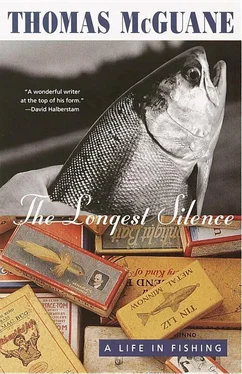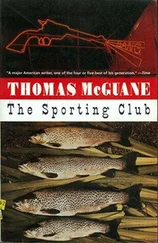Rays are a common sight on the flats. The game fish seldom follow the pretty spotted eagle rays, whose perfection of shape and movement is beyond quick description. They are dark and beautifully spotted like a fawn or leopard; as a wing is lifted to propel them, the exquisite and creamy ventral surfaces are exposed. Spotted eagle rays mud less than stingrays; their oval mouths seem made for more exact procedures. When the boat is upon them they flush with long perfect sweeps of their wings, and when they are lost to the eye the swirls and turbulence of their surprisingly powerful movements continue to disturb the surface.
The platitudinous stingray with his torpid, carpetlike movements, on the other hand, holds some special interest for game fish. Jacks, snappers, and permit will follow a feeding stingray throughout the tide, using the ray as a kind of stalking horse to scare up small fish and crabs. When a fish is found with a ray, it may be assumed that he is feeding rather than traveling. A suitable presentation must be made.
We knew where to find rays, having often seen them on the soft backsides of banks whose harder edges we fished for permit. Our grandly complex set of banks stretched from the Atlantic to the Gulf of Mexico; we had laboriously laid out its tortuous inner channels and developed some sense of the sequence in which permit used its individual flats and banks. But always we had fished the edges.
Today we wanted to go into the interior of the banks on incoming water and fish well up on the soft bottom. We made the long run from Key West in the early morning, the scattered keys looking deep, wet and green on the slate sea. We passed Mule, Archer, Big and Little Mullet, Cottrell, Barracuda, Man, Woman, Ballast, and Boca Grande, on out past the iron marker, west into the first gut.
The flat was dotted with mudding rays. Guy took the pole and we tracked them down one by one, seeing the fleeting red forks or discovering the nervous snappers too late.
Eventually we found a single large snapper working a stingray. The ray was making such an extensive mud that it seemed unlikely the snapper could even see a fly. In any case, the excitement of watching the tailing fish collaborate with the ray and the measuring in my mind’s eye of the breadth of that fork went a long way toward totally eroding my composure.
The mutton snapper was tailing when I cast, and I threw well beyond the ray and retrieved the large fly through the edge of the slick. The tail dropped abruptly, and my first thought was that I had flushed the quarry. Then I saw the wake directly behind my fly and hoped for a take straightaway, but none came. I had to stop the fly and let it go to the bottom, an act that has always felt entirely unnatural to me. The fish tipped up, tail entirely out of the water. I lifted the rod tentatively, then came up tight, and the fish was running.
Water streamed up the leader and the snapper peeled off in a bulge of water tinted by his own brick-red hue. The flat was broad and the snapper failed to clear it to deep water on his first run, at the end of which he turned perpendicular to the line and held there for awhile, implacable as a fire hydrant. Then, with an air of having made the decision himself, he allowed me to retrieve him at his own sullen rate. I began to look around for the net but found Guy one step ahead of me, the big net at parade rest.
My glances for the net were premature. A number of runs remained to be endured. With a fish badly wanted, it is always simple to imagine the hook pulling free, the leader breaking, the dead feeling in the slack rod. Five minutes later the fish was at the boat, succinctly netted by Guy.
It seemed bigger than I expected. A short time after landing the fish we ran into a local guide who weighed our fish: a little over fifteen pounds, the world record on a fly.
That night this best-of-breed was dispatched as follows: deprived of head and innards, he was stuffed with shrimp, shallots, buttered crumbs, parsley, tarragon, and mushrooms, then rinsed down the gullets of hungry anglers with gouts of cold domestic Chablis. I would wish a similar fate upon all world records that are not released at the boat.
The next day Guy took another big fish, this one thirteen pounds, and we began to feel we were getting the hang of it. This fish was given to a Cuban friend at the yard who remembered mutton snappers in the Havana markets. He carried Guy’s fish around in a formal march, under the stored hulls, through the dry shed, and out to the carpenter’s shop, before giving it the place of honor on the front seat of his pickup.
When we looked for the snappers in the next few days we couldn’t find them anywhere. The rays came in on the same tides, but now they were alone. A week or so later the commercial fishermen located the snappers on the 120 contour offshore, 118 feet out of our depth.
BY MARCH IN the keys you’re thinking of tarpon. The fish have been around in small numbers all winter — not quite fishable numbers, somehow — when bonefish and permit have seemed the more logical subjects of attention. Night trollers and drifters have been taking tarpon in the channels and killing them for advertising purposes; they make the only sign a tourist will believe when hung up at the dock. The shrimp basin in Key West and the harbor always have quantities of fish, but these are domesticated brutes, feeding themselves on the culls of the commercial fishermen and rolling and burbling with the reptilian presence that half-tamed alligators used to have on Florida golf courses. We just stare at them unable to account for their feral behavior.
But usually, sometime in March, while permit fishing or bonefishing on an edge adjacent to deeper water, we spot the first string of migrating tarpon, often juvenile fish up to fifty and sixty pounds. Below Key West they inevitably appear to be travelers, pushing wakes and rolling with their eyes coming out of the water. You are absolutely sure they see you in the skiff, transfixed and watching. The whole mystery of their cycle seems contained in the absolutely deliberate way they travel, deliberate as caribou or spring warblers.
Mystery is not an altogether misplaced word regarding tarpon. Much serious research on the fish was dropped when schemes for converting these unparalleled creatures to fertilizer and cat food were abandoned. There seem to be vertical migrations of fish from deep to shallow water, in addition to the fish that appear to be traveling from the south, very probably Central America. But facing a lack of hard information, the angler feels the invitation to elaborate his own sense of the fish’s presence. An awareness arises of the distinction between a species like the tarpon and the offshore pelagic fishes with which, as a game fish, the tarpon is often favorably compared. But in the tarpon, the aerodynamic profiles and chameleonic coloring of blue-water fish are replaced by something venerable; they are inshore fish, heavily scaled; they gulp air; and as if to seal their affinity for the land masses of the earth, they require fresh or brackish water to complete their reproductive cycle. They migrate, as many fishes do, and when we touch or intercept these migrations, we sense, subliminally, the dynamism of the earth: tarpon migrate by season, season is a function of planetary movement, and so on. Which is no more than to say you can face bravely those accusations of loafing when you have ruined a month chasing tarpon, racking your brain to understand their secret, sidling lives.
It is quite early in the morning. Not first light, because a higher angle of sun is required to see fish on the dark bottom we are working today. But it is early enough that as we cross Key West the gas stations are being swept down by sleepy attendants with push brooms, and the Cuban men are over on their end of Duval Street drinking cups of their utterly black coffee and eating bollos . In the still air you can smell the smoke from City Electric on the other side of town. The groundswell of Latinate noise — that first of all the things that make Key West another country — has not yet started, and as we go up Caroline Street all the side streets running down to the shrimp basin, marked for us because of the great trawling booms sticking up among the old wooden houses, are quiet. The shrimpers always line up first under the awning of the Fisherman’s Cafe. No one there yet, though someone is arranging ship-to-shore radios and fathometers in the window of Key West Electronics across the road.
Читать дальше












